If you have ever had squirrels in your attic, you know the incredible amount of headaches that they can cause. If you have been blessed to avoid this common household problem, consider yourself lucky. Regardless, you may want to take steps to prevent squirrels from accessing your attic.
If you follow this site, by now you know that I get most of my post ideas from issues as they arise around my own house. I’ve had issues with deer rubbing my trees, armadillos digging up my plants, and lately, I have been struggling with squirrels in my attic.
Being a home improvement expert, I am well aware that squirrels like to get in attics and call it home. I guess I just hadn’t given it much thought over the past few years. That is, not until it happened to me.
This October I became aware that a family of squirrels was in my attic. Like many, I decided to wait until the kittens were big enough and then evict them.
They say that once the mother is able to leave with her young, it requires no more than sealing every possible entry point to make them go away.
Well, let me just tell you, squirrels are incredibly persistent and determined. Once they decide that your attic is their luxury penthouse, they are very unlikely to leave. No! Matter! What!
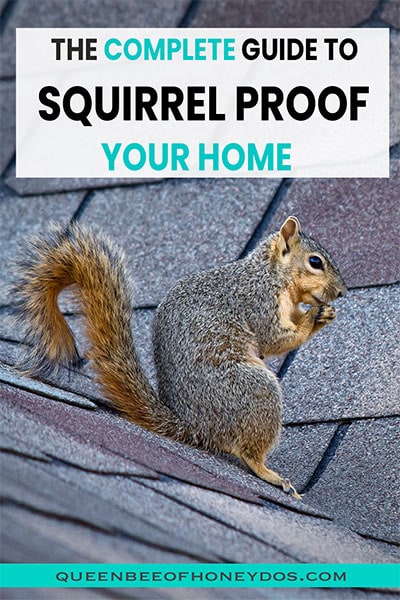
(This post may contain affiliate links (*). That means that I make a small commission from sales that result through these links, at no additional cost to you. You can read my full disclosure here.)
Understanding How Squirrel’s Function Can Shed Light
Now, I know everything that I needed to do to keep the squirrels out. I will get to that in a minute. But, before I got started with evictions, I wanted to understand the law for my area and the most humane actions to take.
I also wanted to get an understanding of their behavior. In the past, I had always handled repairs prior to a problem occurring. Having an actual battle of wills with squirrels was a first for me.
So, I began by checking with my state’s wildlife control center. I also checked with my state’s law and with the Humane Society. The combination really helped me with deciding on how to deal with my issue.
Normal Squirrel Behavior
Of all, the most interesting and useful information came from learning about their behavior. I am not talking about their tenacity. I think that is self-evident for anyone dealing with this issue.
What I am referring to is how they choose a nesting location and what other methods they do to survive. In particular, I was interested in the gray squirrels as these are the most common attic invaders and my current problem.
It may seem unimportant to most, but learning about it left me with no doubt that I wasn’t going to be rid of the little [insert curse word here] anytime soon.
If you don’t need the details on squirrel nature, go ahead and skip to the part on preventing squirrels from accessing your attic. But, if you are trying to get rid of squirrels right now, it may help you to know some of this info.
First, it is almost always a female squirrel that will invade an attic. In fact, the female will normally run off the male once she has finished mating. People often incorrectly assume that there is both mother and father holed up with the babes.
Gray Squirrels typically breed twice per year. In my area, they breed once in late winter and again in late summer. Normally, sometime between the end of December – the first part of February, the female will mate. And again in late August – September.
She may wait until this time to choose her nest location or she may start to look for one a month prior. If she has already used your attic for a previous batch, she is very likely to return again and again for subsequent rounds.
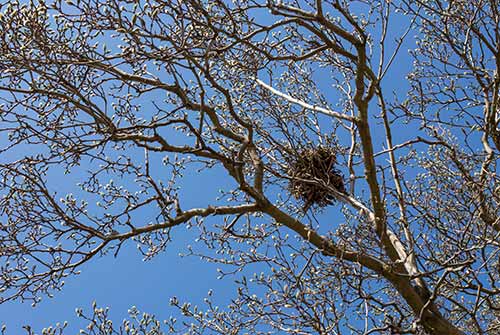
After mating, she begins building the nest where she plans to deliver her kittens. Under normal conditions, she chooses a hollowed-out tree. Attics are basically a HUGE hollow tree with perfect conditions.
She will also build a back-up emergency nest. These are called dreys, and you have probably seen them during the fall close to the top of trees.
They are basically a bundle of leaves and twigs that are located about 30 feet off the ground. These are not their preferred living quarters. But, serve as temporary or emergency locations.
The female will have one drey very close by to the main nest. Often, she will make a second drey a longer distance away in an area where she likes to forage for food.
This additional back-up drey serves mostly as secure quarters should she need to seek shelter when out foraging far from home.
Because the female knows that her young stand a better chance of survival when housed in a hollow tree versus an exposed drey, she will resist moving her young from the more secure location (i.e, your attic). It is best to prevent squirrels from getting into the attic than it is to try to evict them after the fact.
It takes approximately 45 days after breeding for a gray squirrel to have her young. You will likely not hear her in the attic during this time because she attempts to remain quiet for safety. But you may hear her going in and out with nesting materials.
About 4-6 weeks after she has her kits, they begin to run around and chew on any and everything in their path including electrical wire. This is when most people become aware of the problem.
The best time to encourage her to leave is before she is close to delivering her young. Once she no longer has enough time to find a safe area and build a new nest, she is very unlikely to go on her own volition. Let me stress that. VERY. UNLIKELY.
If she has already had her litter, you may as well call it a day. She won’t go without her young. You will need to either wait for them to get big enough to force out or remove them by hand.
Keep in mind that the longer you wait the more damage that will be done to your home, potentially fire causing damage. And she is going to be resistant to leaving regardless of how far into the process she is.
It is sort of like trying to get you to leave your home to go live in a tent. The situation would have to be pretty drastic to make you want to do that.
Pros And Cons of Relocating Squirrels
In my state, the law prohibits transferring wild animals to new locations. They do not want your issue to become a nuisance for someone else.
They also want to prevent the transfer of diseases to a new location. Since squirrels can carry a lot of diseases, this seems like a good practice to me.
In addition, I discovered that squirrels are not likely to survive when relocated, and if done during the winter, it is almost a guarantee that they will suffer a slow agonizing death.
For starters, squirrels are very territorial and will fight for their space. Secondly, relocation means they are being moved into an unknown area where they do not understand the dynamics of those spaces.
In addition, wintertime relocation means that they do not have access to their much worked for stash of food. Add in the extra stress of trying to fend and care for their young, and you can imagine how hard it would be.
The most likely scenario is that they will be picked off by prey before they are able to establish a new habitat. Worse is suffering from starvation during the winter months.
In fact, many professionals focused on humane treatment believe it to be more humane to put the squirrel down rather than relocating.
Now, that is not to say that I am recommending death over relocating. I am only pointing out the facts and suggesting that you consider your course of action in advance.
I also recommend that you first check with your state’s law. Some places do not allow relocating squirrels, other’s do not allow killing them. You can’t do much on your own without knowing what your legal options are.
Options for Trapping Squirrels
Humane Traps
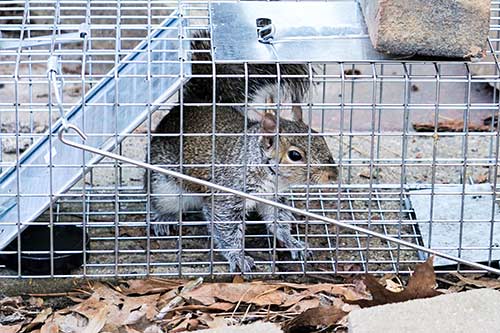
Let me just say right from the start, that trapping a squirrel from inside an attic is nearly impossible. Believe me, I have tried.
In my case, I knew the mother was way too clever to fall for an interior trap, or I strongly suspected it. But, I thought that the kittens wouldn’t be quite so intelligent. So, I thought I would attempt to catch them.
Once the young started running around, I used a Hav-a-Hart trap* in the attic hoping to catch all the young and use them to lure the mother out.
In 30 days, I caught one kitten which managed to escape from the cage before I could do anything with it. After that, they were on to me.
Had I gotten to the younger ones sooner, I could have probably moved them out by hand. Placed in a box outside, the mother would have come around and moved them to a safe location.
Time is of the essence to the mother, and she will choose to take her young to a safe location in a timely manner. It takes far too much effort to try to access a closed-off attic.
If you quickly seal that final exit just after moving the young out, she will have no choice but to go to one of her other alternative dreys.
Exclusion Traps
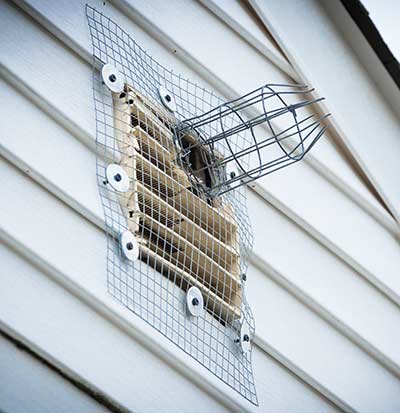
Another alternative is to mount a one-way exclusion door/trap over the exit hole. These are great when you need to prevent a squirrel from getting back into your attic. But, you have to check these every day because it is cruel to leave them longer.
If left too long, they will suffer from thirst and stress at not being able to get back to their young. You should check every 24 hours at a minimum, preferably in the morning, and be prepared to remove them in a timely fashion.
Lethal Traps
If you are required to destroy the squirrel and can not catch-and-release, the best thing to do is to use one of the more humane traps, and then quickly put the animal down once captured.
That being said, there are several lethal traps available; however, they are not really designed to rid one of attic infestations. Squirrels won’t enter these from inside the attic (or are very unlikely to).
In addition, since most lethal traps must be placed outside, you don’t have any guarantee that you are disposing of the “problem” critter. Plus, you will still have to deal with the issue of the kits that are still likely in your attic.
Rat Traps
I have seen some people claim to have caught squirrels in rat traps. It is not impossible, but squirrels (especially gray squirrels) are very good at escaping these.
Snap traps may catch the occasional squirrel but rarely will kill it unless it is modified. They often get away and may end up dying in your walls. Not a pleasant experience.
FYI – I had a modified rat trap located in my attic for two months. It was baited with apples and peanut butter, placed right in their running path, and I caught squat! They were so on to me.
Glue Traps
Glue traps will not hold them and I do not recommend them for several reasons.
First of all, glue traps have to remain dust-free. Attics are anything but. To make matters worse, squirrels run VERY fast and have a lot of momentum going by the time they pass over the trap.
Their bodies are not skimming the ground the way a rat’s body does. The speed and difference in body types usually allow them to glide right over glue traps.
On a side note, glue traps are a really slow and agonizing death. They are far from a humane method. They can also be dangerous for the person using them.
You can’t just pick up the glue boards and dispose of them right after catching a squirrel. They will still be alive and they will be angry. They can and will bite.
You have to let them lay there and suffer for days until they are dead. You will likely hear them struggling and squealing. While I understand the need to remove them at all costs, you want to consider what the results would be if you do happen to catch one in this type of trap.
How To Make Your Home Squirrel Proof
The first step to prevent squirrels from getting into your attic, and by far the most important one, is to keep them from getting on your roof. Now, you aren’t going to be able to completely prevent this from happening, but you can make it less likely.
Keeping Squirrels Out of Trees
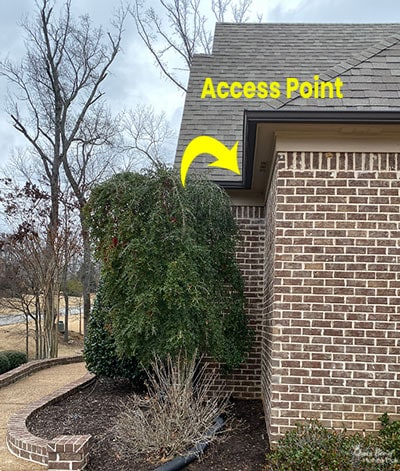
For starters, you want to squirrel-proof any landscaping near your home. If you have a tree close to your house, especially if the tree branches hang over the roofline, trim those back.
Even with doing that, sometimes you will miss something. This is the access point for my problem. (above image) This weeping Yaupon is a favorite for the invaders in my home.
Even though I have it trimmed away from the house and there are no obvious branches hanging over the house, it is still close enough for them to scurry up it and jump to the roofline. Which is exactly what they do.
So, if the tree presents a situation where you can’t completely prevent access to your roof, you have a few options. One, you could just cut it down.
If that is not an option for you, you can make a baffle to go around large trunks. Purchasable baffles* are available that will work on smaller trucks. This will prevent them from climbing up. However, if an adjacent tree’s limbs extend over this tree, they can still jump across. So, keep that in mind.
Keeping Squirrels Out of Gutters
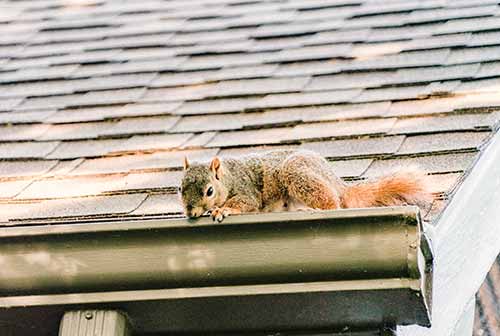
Once the access points to your roof are taken care of, you can move on to squirrel proofing your house because even though they may not be able to get to the roof via your trees, a determined squirrel will search for another way.
They can climb just about anything, and although the trees are how most of them will discover your roof, once they have made that discovery they are not opposed to climbing brick walls, any wooden structures, and even siding. So, you must still tackle the roof and gutters.
If a squirrel manages to get inside the gutters, it is going to almost always lead to a squirrel in your attic. This is because they can feel the air and change in temperature coming from the builder’s gap, vents, and any other cracks.
The gutters also offer them plenty of opportunities to work at chewing a hole in a relatively comfortable setting. It provides a hidden and safe means to enter and exit, and often those builder’s gaps provide them plenty of space to get in without them doing anything at all.
If you can keep them out of your gutters, you have already won half the battle. Installing gutter guards is by far the best solution for issues with both gutters and builder’s gap.
The builder’s gap is the most common way that a squirrel first accesses an attic. To prevent squirrels from getting into the attic, you must address this problem.
If you want to forego the gutter guards, but you still want to seal off that builder’s gap, you can install a drip edge. Most pest control businesses will want to install either thin flashing or mesh hardware.
While the mesh hardware will definitely work, the drip edge will do the same job as far as squirrels are concerned and it comes with the added benefit of helping with water damage.
I wouldn’t use thin flashing strips for anything other than as a temporary seal. They can chew through it if they are determined, and you will be right back where you started. So, use the flashing to prevent new infestations, but plan to install drip guards at a later date.
How to Cover Builder’s Gaps with Flashing and/or Mesh Hardware:
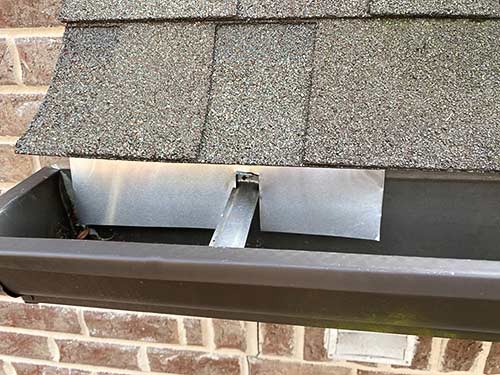
If you do choose to use flashing or mesh hardware, the installation process is simple and easy for the average DIYer and should take you about a full day to complete.
You will need to cut strips from your chosen material that is about 12″ long and is wide enough to cover both the gap and also to extend down into the gutters.
You will also need to use 1″ – 1 1/2″ roofing screws with sealing washers.* Regular screws will not be waterproof. These screws are galvanized and self-sealing. It is also a good idea to place a dollop of 100% silicone over each screw head for extra protection.
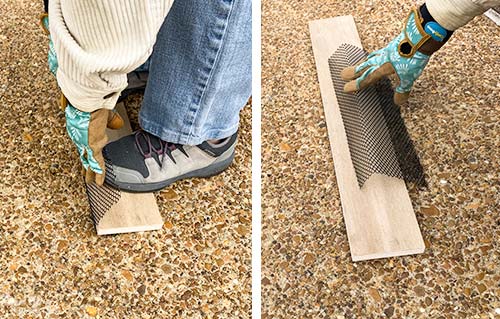
When I install mesh or temporary flashing, I cut the flashing and/or mesh hardware with metal snips. Then, I use a plank or board to use to create a bend in the material. (FYI – I am using some of my gutter guards to create these pieces to reinforce problem areas).
The wider portion will slide beneath the first row of roofing shingle and the shorter half will rest inside the gutter. This is the same install method used to install drip edging and how I install temporary flashing strips.
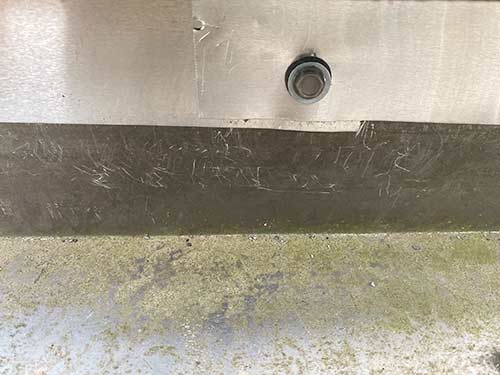
To attach it, I place a screw through the flashing/mesh about every 6″. The screw goes through the material and into the fascia board. This is why I like to use permanent materials from the start. That is a lot of screw holes and I don’t like to disturb them once they are sealed.
You can see in the image above that there are a bunch of tiny scratch marks along the backside of this gutter section. These are squirrel claw marks. These marks let me know that the squirrel been trying very hard to get in at this location.
Because the squirrel had been so active in this spot, I decided to double up on my efforts to keep it out. The flashing is going to be removed once I get around to installing a drip edge. But it did the job that I needed it to do for the time being.
Tackle Other Problem Zones
After the landscaping and gutters have been taken care of, it is time to address other potential problems. While the gutters are going to be the most likely source of the initial problem, there are other areas where squirrels like to use and/or notice air changes.
Chimney and Roof Vents
For starters, they LOVE chimneys. Again, these are like a big hollow tree for them. A perfect location for storing nuts and building dreys. If you have a chimney flue, cover it with a metal chimney cap.*
This goes for any other opening or roof vent. Think like a squirrel. If there is a lip, ledge, or a corner that they can get their teeth around, they will chew on it to gain entrance. To prevent this, install galvanized steel vent covers* to all weak points.
Gable Vents
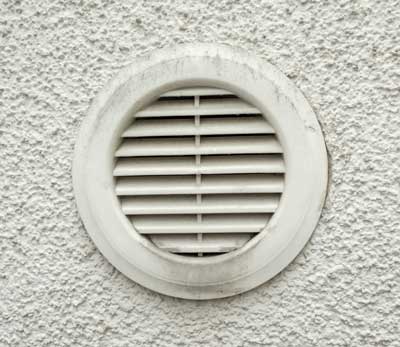
Gable vents are another popular point of entry for squirrels. Like gutters, these offer a nice place for them to sit while they do their chewing. And they are sort of like a big window that entices them to come inside.
To prevent squirrels from accessing the attic via the gable vents, you will need to use hardware cloth to seal these off. Some of these already come with mesh cloth on the interior side.
However, if you already have a problem with squirrels on your roof or in your attic, you will be much better off with the hardware cloth on the exterior side.
You can alter them simply by screwing or nailing hardware cloth over the vent. Make sure to use roofing nails or screws with the sealing washers. Trim can be added to create a finished look.
Dormers and Easy Access Soffits
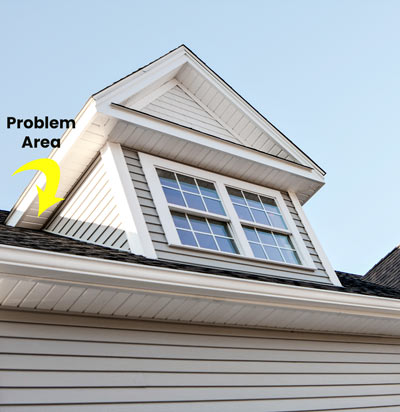
Another location that is a favorite of critters is the soffits, especially those on dormers. Again we have a spot where they can comfortably sit while they work.
To make matters worse, a lot of soffits have gaps right where they meet the roofline. All it takes is a small gap to allow then to enter unimpeded. And if the gap isn’t large enough, they will chew on it until it is.
Often, the soffits are not securely attached in these tight spots and the squirrels (or other critters) just push up on the soffits and enter without leaving any trace of an entry point.
To correct these loose soffits panels, you can remove the panels along the dormer and add plywood beneath them. This way, the panels can’t be pushed up to allow access.
To prevent squirrels from accessing the attic through these gaps, flashing or hardware cloth can be attached.
Roof Intersections
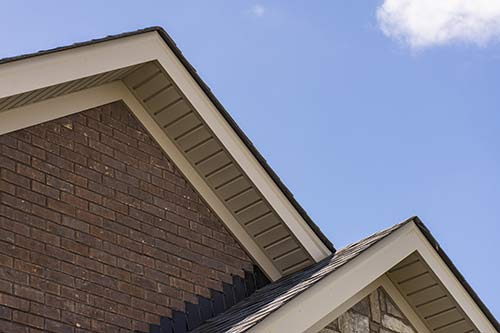
Squirrels will also use any roof intersection as a means of entering the attic. It is the same concept as the dormers and can be treated in the same fashion.
Clean-up from Previous Issues:
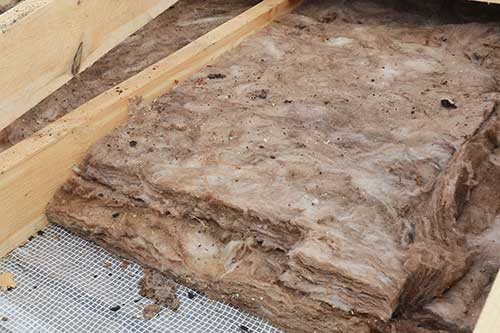
The very last step to prevent other squirrels from trying to enter the attic is the clean-up. If you have already had a squirrel problem, you will need to address issues in your attic.
I am not going into wood or electrical repairs in this post, but you should address the issue of feces and urine if you do not want other squirrels trying to get in.
Squirrels make a huge mess in your attic and insulation. Besides the potential for health problems coming from this mess, there is also a problem with the smell attracting more squirrels.
Yes, other squirrels (and even predators) can smell where attic squirrels have lived. This serves as an invitation for them to make use of your attic, as well.
To eliminate this smell and potential health hazard, you have to sterilize and remove the old material. You can do that with a mix of bleach and water (per the CDC), this should be 1part bleach to 10 parts water).
First, lightly spray the areas containing feces and urine. Then, remove any loose feces with a shop vac or with paper towels. Make sure that you wear gloves and a protective mask* when doing the clean-up.
Insulation bats that have been contaminated should also be sprayed and then removed. Allow the spray to soak into the feces for several minutes and then bag up the damaged sections.
Best Materials To Use To Prevent Squirrels in Attic Spaces
Flashing:
Flashing* is great because it is slick and offers no ridges for a squirrel to wrap their teeth around. When used in the right situations it is a wonderful deterrent.
When it doesn’t work is usually because it has been bent in a way that provides a surface that they can get their jaws around. It doesn’t take much of a ridge or lip for a squirrel to be able to get started.
Use Flashing Properly
Apply flashing in areas where the material can remain flat or folds can be placed inward and in tight locations.
Avoid wrapping around outward-facing corners and leaving loose edges or easy to access ridges/lips.
Heavier gauged flashing will present more of a challenge for determined squirrels. While light gauge flashing will provide some protection, I would only use it for temporary applications or in areas where it would be difficult to chew through.
Hardware Cloth:
Hardware cloth* is great because squirrels can’t get their teeth around the small spacing provided. It works better than flashing in most locations because there is not an issue with creating bends.
Installing Hardware Cloth
To properly install hardware cloth or other metal mesh, make sure that you are using galvanized or weatherproof material with 1/4″ openings or less.
Use roofing screws or nails with sealing washers to attach to surfaces.
Repellants:
Repellants can be a hit or a miss. By themselves, you will not be able to get your home squirrel proof, but you can use them as an add-on for the other materials to help deter the squirrels.
After sealing my house, I have been using Coyote urine* as a repellant. I am applying it weekly and after each rain. I plan to use it just during the breeding seasons as an extra means to scare them away from the perimeter of my house.
Some repellants work better than others. Some do not work at all. None will secure your home. At most, they lend assistance.
I have found that the ones that are best for preventing them from getting into the attics are adrenaline-inducing. (i.e the coyote urine causes fear when they smell it).
Other DIY repellants may be annoying or unpleasant, but I haven’t had any luck when it comes to making them want to stay away from my house. Most of the time, they just wait it out. (see below for all the steps I used during my personal squirrel eviction).
How I Caught The Squirrels In My Attic
So, now that I have covered all the basics, I will tell you how I got rid of the three unwelcome visitors in my home.
As I said before, I checked with my local and state requirements and recommendations before tackling this problem. I also gave the little buggers time to reach a mature enough age to depart and survive on there own.
In fact, I gave them all the way up until they were right at the age where the mother squirrel would be ready to force them out and start getting ready for her next batch.
Unfortunately, they were not appreciative of my generosity. For several weeks, I did what I could to discourage them and to make my attic inhospitable.
Every day, I made my way up there for hand-to-hand combat. Armed with my flashlight and jug of ammonia, I entered their living zone.
Sometimes they would pop their heads up and look at me. Then, they would dart for the exit hole that they had chewed in my fascia board. A few times, I received a growl or angry chatter. (one juvenile was way more vocal than the other).
I would spray their area down with the ammonia which they hated. I know this to be true because I would hear the mother up there tearing apart her nest and raising a ruckus after the smell dissipated enough for her to return.
So I verified the claim that they are not fond of that smell. But, I also discovered that it has to be sprayed right in their preferred area for it to work. I should also point out that they are just as likely to move to a different area of the attic as they are to flee.
Anyway, I kept this up every day in an attempt to run them out for as long as possible. My thinking was that as long as they weren’t inside during the day, they wouldn’t have as much opportunity to destroy wires.
I also hoped that it would eventually make them see that my attic was too dangerous. But, no. They preferred to stay and fight the good fight.
We finally reached the point where I saw that they were not going to go on their own. This was mid-December and I was sure the mother was getting close to breeding again.
The clock was ticking and I was nearing nuclear mode. So, I started closing up and sealing every possible weak spot on my roof. Dormers, gutters, roof gaps, etc. I spent a week working on everything to squirrel-proof my house.
Then, came the final step. Locking the little rat $#@! out. I knew where their favorite doorway was, and I had saved it for last. Incidentally, they were entering through the fascia by way of the gutter behind that weeping Yaupon mentioned before.
Since this spot was right above my master bathroom, I could hear them leave and enter every morning and evening. So, as soon as I heard them leaving the next day, I headed out and added the final piece of gutter guard.
Problem solved! Yes!
NOOOOO! One of the juveniles kept coming back to the gutter guard located over their old entrance. He would pull and tug on it for about 10 minutes every day before giving up.
But within a week, the juvenile had found an intersection in the roof that I had missed and was able to wiggle back in. Naturally, the other two followed. I should note that I am positive that there were no baby squirrels left inside to cause such determination.
Okay. Now, I had reached the very end of my good generosity. It was apparent to me that these squirrels weren’t giving up, and I needed to take stronger action to prevent these squirrels from getting back inside my attic.
They decided that they liked my house, and I could see that they were always going to be a problem. Sorry folks. But, it comes down to them or the endangerment of my family. There is no contest.
I decided that the only solution was going to have to be a permanent one. As much as I hate the idea, these squirrels were too familiar with my home and had given me no choice.
Because of the location of the entrance (right in an interior corner where the fascia meets the gutter), I wasn’t sure that I could catch them with a one-way trap.
The space was incredibly tight, and even if I could rig up a trap in that awkward location, I didn’t relish the idea of having to remove such a small container with an angry squirrel in it.
So, what I did was use the downspouts as my traps. I know, that sounds weird. Stick with me for a minute.
I first located the new entrance and sealed and repaired it. Then, I placed the last gutter guard back in place over their favorite entrance.
Because the gutter guards were so secure, they couldn’t get out through any means except to go down the downspout. At the end of the downspouts, I had rigged up a one-way trap.
Once I caught them, I quickly put them down. I am not going into the unpleasant details. I followed my state’s recommendations and will leave it a that.
I have now completely sealed off every weak point in my house and am using the coyote urine to keep other curious squirrels at bay.
Final Comments:
It has been 30 days now, and I am still squirrel free. As I said before, I am applying the repellent weekly to encourage any other squirrels to move along.
I have not seen any near the house or flower beds. So, I assume the stuff is working. I am also confident that no other squirrels will be able to get into the attic. The gutter guards were by far the best solution, but it was a combination of steps that allows me to sleep better at night.

Mona says
OMG ! I cannot believe all that you had to go through just to get the squirrels out of your attic. I really appreciated you sharing that with everyone. I don’t feel sorry for you –cause I feel sorry for myself. I came on your site to find out what plants deer like and ended up reading this article. I know I have squirrels in my attic and have not tackled it yet. I also had no idea it was so dangerous. Every time we have been up there, they are not there. So will forward this to my husband and can start on yet one more project. Now I understand why so many fires seem to start in the attic. I don’t feel sorry for you because you tackled the problem and are out on the other side of that problem. I am just beginning.
Rachel Lynn says
Mona, I wish you the best of luck! I still sometimes wake-up at night, if the house creaks, thinking that I heard a squirrel. lol Just some sort of PTSD I think. ? I will keep my fingers crossed for you.
Devin says
Hell of a story! Super helpful though – thank you. I’ve got a bit of a squirrel issue going on myself. Black squirrels, not grey ones. I thought I would be smart and cut down all the branches of the tree they were using to get in but they just decided to climb up the edge of the building and somersault over the overhang. So now it’s onto Defcon Level 2: drip edging, wire mesh, and a good pest control guy lol.
Thanks for teaching me how drip edging works!
Now I’ve got about a thousand trips to make up and down a ladder…
Rachel Lynn says
Glad I could help. Take care making those trips on your ladder, and good luck!
Sara W says
Hello! I am (unfortunately) happy to have found your post with so much detail. One question I have is about walls. I am in Central CA and have been witnessing what I now know to be a squirrel in my garage. It was on top of stacked boxes so I believe a good amount of moving and cleaning up in the garage will make her believe that spot is not safe and she’ll abandon on it. We have however been hearing her in our crawl space and now down into a wall. We live in a single story with only a crawl space and not a proper attic. How do you go about cleaning out a wall?
Rachel Lynn says
Sara, walls can be a bit more difficult. Usually, you will need to remove some of the drywall to get to the nest and mess. First, you will want to make sure that she can’t get back in and that she doesn’t have any kits in that wall. I know it seems like a few simple changes will run them off, but you will likely find that you will have to take more drastic actions against it now that it has made the decision to nest there. You want to make absolutely certain that she can’t get back inside before doing your repairs. For that, I would buy a scope camera that can be inserted through a small hole to see what is what. I have this one from Amazon. The price is reasonable, and you only need to drill a small hole into the area where you hear activity. Use it to see/locate where she has made her nest in the wall before you start removing drywall. That way you only remove what is absolutely necessary.
Loft and Insulation says
Great job! Thanks for posting it.
Shelter4GreenDeal says
I loved reading your article. Thanks for sharing it with us.
Barbara says
Dear Rachel Lynn!
I have read many articles, but none gave as much good information as yours. I have a long house with an inaccessible attic- at it’s highest point it might be 4 feet, and at the lowest maybe 8 in. The squirrel sounds of rolling nuts were the only thing I heard in late Dec. mostly around 9:30 pm or so. I then started stamping around this area on my flat roof. Within two days I did not hear anything. I read that you can put in a wad of paper in the hole, and if it is gone, the squirrel pushed it out to leave -or conversely, pulled it out to re-enter.
At first the paper remained in the hole for 2 days, then it was out early in the morning. I was swearing, as I was hoping I scared them out. I wanted to have a drip edge installed when I knew it/they were finally out. I stamped around that area again, where it must have been mighty loud for the short space it was in, and put the paper back in. Again, 2 days later the paper was out. I cannot tell if she is being quiet and staying inside a lot now, or if she is coming back to get her stash of nuts or what… (But I never hear those nuts anymore). I want to of course make sure she is out before I close off the fascia hole I found. (with a mirror taped to a pole! Luckily I have a flat roof :)!)
I am wondering if this is my problem- did I read this on your site?- that the mother can be very quiet as she (begins?) to nest. I read that this squirrel (Eastern Fox squirrel) in Illinois will have its kittens in February, and that if you make it feel it is dangerous for her young, she will leave if she has not had them yet. I am stamping on the roof more now. Since I did that I have not heard it.
But it maybe it comes or go about every other day. I read they do go to other dreys periodically. But I do not hear them at night anymore, and I live on the top floor and listen thorough-out, in case it moved its nest further down the house :(((((. But so far no noise. BUT is she in nesting mode and is just being quiet? Did you happen to try a flashing strobe lights too by chance? I am wondering if I need to have more than the sound of the roof caving in on her…
Thank you- any help on this would be so appreciated. I think it is worth adding any additional info to your article also, that you may have picked up since then too, as it is quite good and in this case, more is better too ;).
Please respond as soon as you can! She may be almost 2-3 weeks pregnant?? Thank you, Rachel Lynn!
Best,
Barbara
Rachel Lynn says
Barbara, In my experience, they do not leave that easily. Most likely, she is nesting. She will leave every day or so to tend to her needs. The previous noise was probably her getting things ready. In about 6 weeks, you will likely hear the pups running around. From sun up till sun down, it will be obvious. They are generally quiet at night. Best of luck.